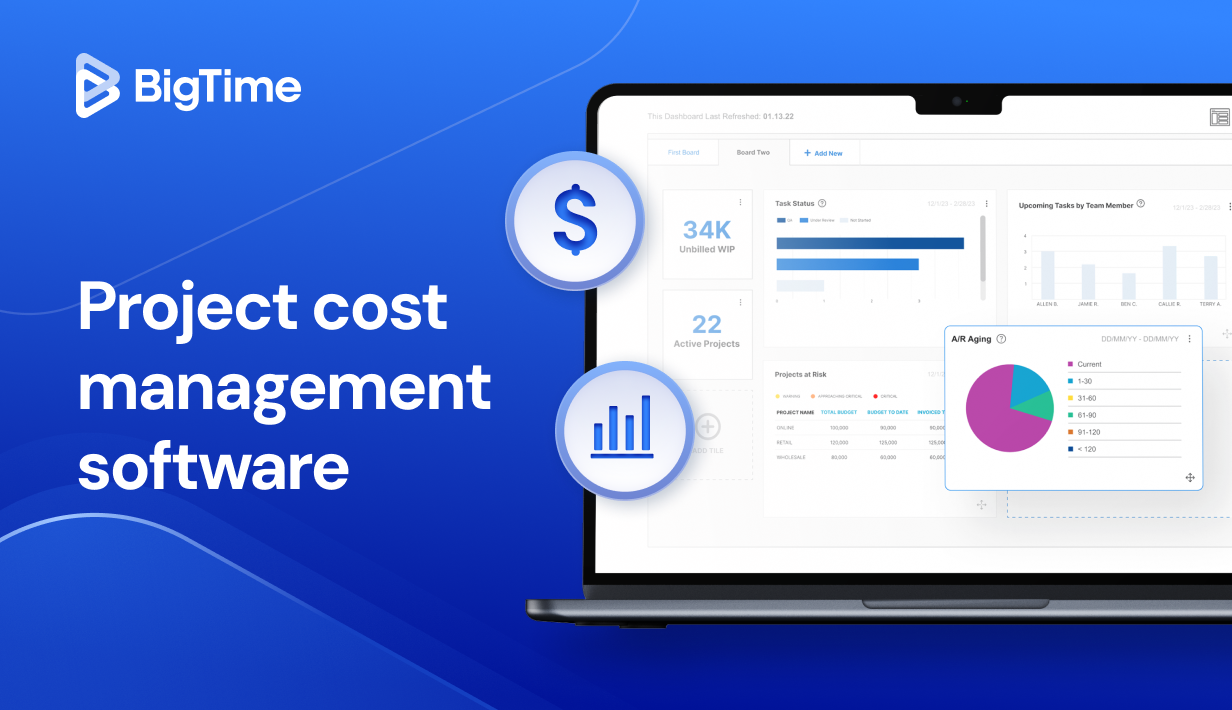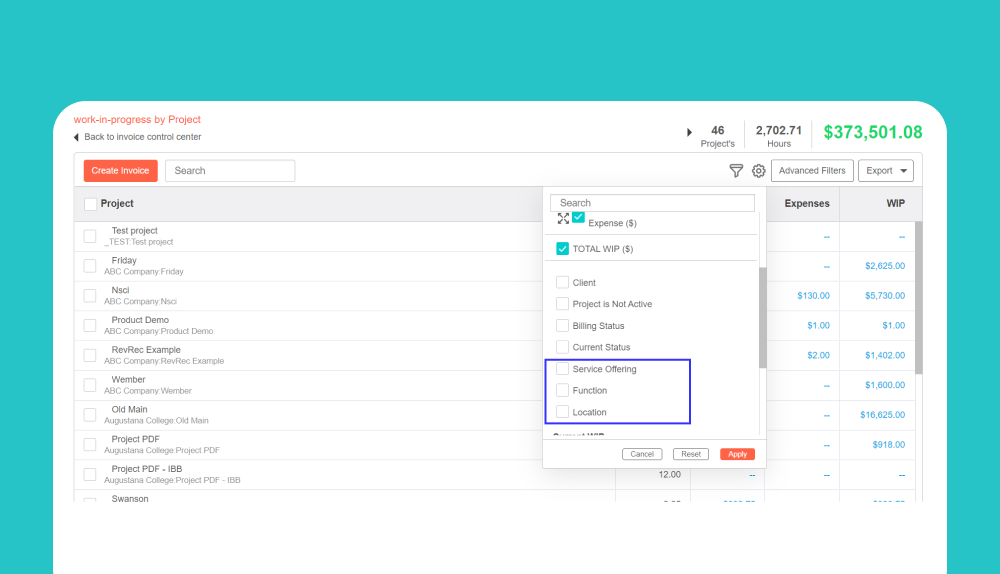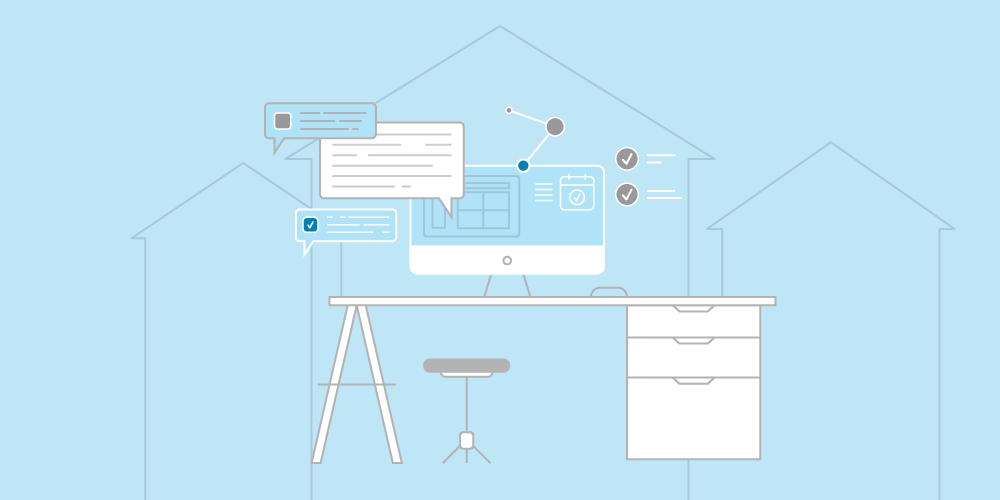Managing project costs effectively is a challenge every business faces, especially as projects become larger and more complex. That is why project cost management software is essential – it helps teams estimate, track, and control spending in real time, ensuring budgets stay on target and profits remain predictable.
In this guide, we’ll explore what project cost management software is, its key benefits and features, how to choose the right one, and our ranking of the best project cost management software options for 2025.
What Is Project Cost Management Software?
Project cost management software helps businesses plan, estimate, allocate, and monitor project budgets throughout the entire project lifecycle. It centralizes all cost-related data, making it easier for managers to track expenses, manage resources, and ensure financial accountability across teams and departments.
In simple terms, project cost management software is a digital solution that integrates budgeting, financial forecasting, and reporting to give organizations full control over project finances. These platforms eliminate manual data entry and guesswork by offering automated cost tracking that help teams avoid overspending and improve profitability.
The Benefits of Project Cost Management Software
Implementing project cost management software offers far more than simple budgeting capabilities. Its main benefits include:
- Accurate budgeting and forecasting: Project cost management software leverages real-time data and historical trends to produce reliable financial projections and prevent cost overruns.
- Enhanced financial visibility: Cost management features centralize all cost-related information, including wages and overheads, allowing managers to track spending and compare planned vs. actual costs across all projects.
- Better resource allocation: Resource management with financial tracking gives managers a real-time visibility of cost data, improving their allocations and boosting profitability in key projects.
- Improved collaboration: Project cost management tools integrate seamlessly with other project management and accounting systems, ensuring all stakeholders work with the same financial data without any manual updates.
- Streamlined reporting and compliance: The best tools for project cost management offer advanced reporting with templates and AI insights, helping managers monitor project success every step of the way.
- Increased profitability: By improving cost control and efficiency, the software helps organizations deliver projects more profitably and maintain healthier margins.
What Features Should the Best Project Cost Management Software Have?
Choosing the best project cost management software means finding a tool that not only tracks expenses but also integrates seamlessly with your entire project management workflow. The top systems go beyond simple cost tracking — they provide deep financial insight, automate reporting, and enable proactive decision-making that keeps projects profitable and on schedule.
Here are the essential features every high-performing project cost management system should offer to ensure successful project delivery:
Comprehensive Budgeting and Forecasting
A strong budgeting module lets you create detailed project budgets, set spending limits, and adjust forecasts as projects evolve. The best solutions also support scenario planning, helping you anticipate how changes in scope or resources might affect costs, as well as overhead monitoring for improved accuracy in your calculations.
Real-Time Cost Tracking
This feature ensures that all project expenses, from labor hours to materials and overhead, are captured in real time. It allows managers to instantly compare planned costs to actuals and take corrective actions before overruns occur – even in complex projects.
Time and Expense Management
Integrated time tracking helps teams record billable and non-billable hours, while expense management tools ensure that reimbursements and cost approvals stay within budget limits. The best project cost management tools also include invoicing and billing, covering the entire sales process in a single tool.
Resource Planning and Allocation
Creating a project plan is just an introduction to the actual cost management – and, for that reason, every cost management software should have it. The best tools in this category connect financial tracking with resource management, allowing leaders to manage workload and cost efficiency simultaneously.
Reporting and Dashboards
Customizable dashboards and automated reports provide a clear overview of project performance, cost breakdowns, and project management metrics. This makes it easier to share data with clients or stakeholders, making it the best way to monitor project health.
Integration Capabilities
To maximize efficiency, the software should integrate with ERP, accounting, and project management systems. This reduces data duplication and ensures financial consistency across all business platforms. It can also improve communication and reduce errors in individual departments and their managers.
2025 Project Cost Management Software Ranking
In 2025, the best project cost management software solutions combine automation, real-time data, and advanced financial reports to help teams manage budgets more effectively. These tools not only track expenses but also forecast costs, improve reporting, and integrate with other project management systems for seamless financial control.
Our 2025 ranking highlights the top-performing platforms based on functionality, ease of use, integrations, pricing, and user reviews from sources like G2 and Capterra. Whether you manage construction, IT, or professional services projects, these tools deliver the accuracy and insights needed to keep every project on budget.
Project Cost Management Software Comparison
| Tool | Description | Strengths | Limitations |
| BigTime | A comprehensive professional services automation (PSA) platform designed for time tracking, budgeting, and cost management. | Advanced reporting, real-time budget tracking, and excellent integrations with accounting tools. | Limited offline functionality; best suited for service-based industries. |
| Wrike | A flexible project management platform with budgeting and time tracking capabilities. | Strong collaboration tools and customizable dashboards. | Cost tracking features not as detailed as dedicated financial software. |
| Mavenlink (Kantata) | Combines resource management, project tracking, and financial management in one solution. | Excellent for managing project margins and resource utilization. | Can be complex to set up; higher learning curve for new users. |
| Smartsheet | A spreadsheet-style work management platform with cost tracking add-ons. | Highly customizable and familiar interface for Excel users. | Lacks advanced forecasting and automation features. |
| ClickUp | An all-in-one project management tool with task, time, and cost tracking modules. | Affordable pricing, easy to use, and great for small teams. | Financial reporting is basic; limited integration depth with accounting tools. |
| Asana | A popular project management system with limited budgeting extensions. | Intuitive interface and strong collaboration features. | Lacks native cost tracking; relies on integrations for financial data. |
| Deltek Vantagepoint | A powerful ERP and project cost management system tailored for professional services. | Strong forecasting tools, analytics, and scalability. | Pricing can be high; best suited for mid-to-large enterprises. |
| Zoho Projects | A budget-friendly tool for small to mid-sized teams with basic cost management options. | Easy setup, integrations with Zoho suite, and transparent pricing. | Limited advanced financial features and analytics. |
BigTime
Reviews: G2: 4.7 | Capterra: 4.6
Pros:
- Comprehensive financial control: BigTime provides precise budgeting, forecasting, and cost-tracking tools tailored for professional services and project-based businesses, making cash flow monitoring easier than ever.
- Seamless integrations: Connects easily with QuickBooks, Sage Intacct, and other accounting software for real-time synchronization of financial data.
- Powerful reporting and dashboards: Customizable reports give managers complete control and clear visibility into project profitability, billable utilization, and budget health, helping them make informed decisions.
- Excellent user experience: Intuitive design and flexible configuration options make it easy to adapt to different workflows and industries.
- Scalable solution: Supports growing teams with advanced automation, approval workflows, and multi-level project management.
Cons:
- Limited offline functionality: Users need an internet connection for most features.
- Primarily focused on service-based industries: May be less suitable for construction or manufacturing projects.
BigTime is an industry-leading project cost management software built specifically for professional services firms, including consultants, architects, IT providers, and engineers. It allows users to manage time, expenses, and budgets from a single platform while maintaining full visibility into project performance. By integrating directly with accounting and CRM systems, BigTime ensures that cost data stays consistent and up to date across your business ecosystem.
The platform’s real-time dashboards make it easy to identify potential budget overruns and monitor profitability by client, project, or team. Its automation features streamline workflows such as timesheet approvals, invoicing, and resource allocation, saving both time and administrative costs. With strong financial reporting capabilities, organizations can better forecast revenue, track margins, and make informed business decisions that drive long-term growth.
Key Features:
- Budgeting and forecasting: Build precise project budgets using multiple currencies and update them dynamically based on real-time data. Use scenario testing to create accurate forecasts and choose the best path for your project and business.
- Time and expense tracking: Capture billable hours and expenses with automated approvals and expense categorization and turn them into project progress in one centralized platform instead of dozens of spreadsheets.
- Profitability dashboards: Analyze project performance with in-depth financial insights. Use project controls to capture both individual KPIs and the bigger picture of your operations, avoiding cost overruns and boosting profitability.
- Invoicing automation: Generate professional invoices directly linked to approved timesheets and budgets and turn value management into a simple process.
- Integrations: Connects with accounting systems (QuickBooks, Sage Intacct, Xero), CRM tools, and payroll platforms to boost productivity, reduce errors and eliminate manual processes.
- Resource management: Assign and monitor team workload to maximize utilization and minimize idle time. Conduct a predictive analytics to ensure that work costs do not exceed your budget and optimize spendings while planning.
Pricing: BigTime offers flexible pricing plans based on the size of your organization and feature requirements. Plans typically start around $20 per user/month, with advanced features available in higher tiers. A free trial and personalized demo are available to help you explore the platform.

Wrike
Reviews: G2: 4.2 | Capterra: 4.3
Pros:
- Flexible project setup: Offers customizable project views, including Gantt charts and Kanban boards.
- Strong collaboration tools: Built-in file sharing, comments, and notifications keep teams connected.
- Automation options: Reduces repetitive work with automated task assignments and approvals.
Cons:
- Limited cost management depth: Budgeting and financial tracking are basic compared to specialized platforms.
- Complex setup: Customizing dashboards and workflows can be time-consuming.
- Higher cost for full functionality: Advanced features require premium tiers.
Wrike is a capable software project cost management tool for teams that prioritize collaboration and flexibility. While it supports basic budget tracking and time logging, its financial capabilities fall short of true project cost management software standards. Most users rely on integrations with accounting tools like QuickBooks or Xero to fill these gaps.
The platform performs well for small teams managing multiple projects but lacks the advanced forecasting, margin analysis, and reporting features found in more specialized solutions. Wrike’s greatest strength lies in its adaptability, but businesses needing deeper financial insights may find it insufficient for long-term cost control and change management.
Key Features:
- Budget and time tracking for simple project cost visibility.
- Customizable dashboards and reports for performance monitoring.
- Resource and workload management tools.
- Integrations with accounting systems and CRMs.
Pricing: Wrike offers a free plan, with paid tiers starting around $9.80 per user/month. Financial tools and analytics are only available in the higher-priced plans.
Mavenlink (Kantata)
Reviews: G2: 4.3 | Capterra: 4.2
Pros:
- Comprehensive project and resource management: Strong capabilities for managing budgets, utilization, and staffing.
- Excellent financial forecasting: Provides clear visibility into revenue projections, costs, and margins.
- Enterprise-grade reporting: Offers powerful analytics and dashboards for data-driven decision-making.
Cons:
- Complex setup and steep learning curve: Configuration and onboarding require time and training.
- High pricing for small teams: More suitable for medium to large organizations with larger budgets.
- Interface feels dated: Some users find the navigation less intuitive than modern competitors.
Mavenlink, now part of Kantata, positions itself as an advanced project cost management software for professional services firms, combining project execution, budgeting, and financial forecasting in one system. While it delivers excellent insights into project profitability and resource performance, it comes with significant complexity. Many users report that mastering its configuration and reporting tools takes time, and smaller organizations may find it more cumbersome than beneficial.
Its biggest strength lies in financial accuracy and predictive analytics — but this also makes it better suited for enterprises with dedicated project management and finance teams. For small and medium agencies or consultancies seeking quick setup and usability, Mavenlink may feel overly technical and expensive.
Key Features:
- Advanced forecasting and margin analysis: Predict financial outcomes and monitor performance in real time.
- Resource management: Optimize team utilization and balance workloads.
- Budget tracking: Compare planned vs. actual costs across multiple project to avoid costly overruns.
- Comprehensive reporting: Visual dashboards for financial and operational insights.
- Integrations: Works with major CRMs, ERPs, and accounting systems for data synchronization.
Pricing: Mavenlink (Kantata) offers custom pricing based on company size and requirements. It’s best suited for mid- to large-sized professional services firms looking for a powerful, data-driven solution to manage complex financial workflows.
Smartsheet
Reviews: G2: 4.4 | Capterra: 4.5
Pros:
- Familiar interface: Resembles a spreadsheet, making it easy for new users to adapt quickly.
- Highly customizable: Users can tailor templates, reports, and dashboards for different project types.
- Strong collaboration tools: Enables real-time sharing, commenting, and version control.
Cons:
- Limited financial depth: Lacks advanced budgeting and forecasting features found in dedicated cost management platforms.
- Manual upkeep: Without automation add-ons, tracking and updating costs can become time-consuming.
- Scalability issues: Managing large, complex projects can make Smartsheet cluttered and difficult to navigate.
Smartsheet is a flexible project cost management tool that bridges traditional spreadsheets and full-scale project management systems. It’s popular among teams that value familiarity and flexibility but don’t need advanced financial modeling. While Smartsheet does include cost tracking and reporting options, it functions best when integrated with external accounting or ERP systems to fill in financial gaps and reduce risk.
The platform’s biggest appeal lies in its customization potential. Users can design workflows and dashboards for budgeting, tracking expenses, and visualizing project progress. However, as projects grow in size and complexity, maintaining financial accuracy and avoiding potential overruns becomes challenging without automation and dedicated cost modules. For organizations seeking simple cost oversight rather than detailed financial control, Smartsheet is a practical but limited choice for monitoring overall budget.
Key Features:
- Customizable templates for budget tracking and project monitoring.
- Shared workspaces for collaboration and approvals.
- Basic reporting and visual dashboards.
- Integrations with accounting tools like QuickBooks and Xero.
- Workflow automation through premium add-ons.
Pricing: Smartsheet offers plans starting at $9 per user/month for basic functionality, with Business and Enterprise tiers offering more advanced automation and integrations. For advanced cost tracking, add-ons or integrations are often required.
ClickUp
Reviews: G2: 4.7 | Capterra: 4.6
Pros:
- All-in-one platform: Combines task management, time tracking, and budgeting tools in a single workspace.
- Highly customizable: Users can adapt workflows, views, and automations for nearly any project type.
- Affordable pricing: Offers strong functionality for small teams at a low cost.
Cons:
- Limited cost management depth: Financial tracking and reporting are basic compared to dedicated project cost software.
- Overwhelming feature set: The wide range of customization options can be confusing for new users.
- Reporting requires setup: Prebuilt reports lack the financial granularity needed for advanced project forecasting.
ClickUp is a popular all-purpose project cost management tool that appeals to teams seeking flexibility without breaking the budget of their capital projects. While primarily a task and productivity platform, ClickUp includes modules for time tracking, budgeting, and simple expense management. It provides a visual, modern interface and integrates with accounting tools like QuickBooks or Xero for basic financial synchronization.
However, ClickUp’s cost tracking features remain relatively light. It lacks the forecasting, variance analysis, and detailed profit reporting that more specialized software project cost management platforms provide, helping projects managers gain real-time visibility into current expenses and historical data. The system shines for smaller businesses and startups that need a unified workspace for team collaboration, scheduling, and light budgeting — but larger firms may find it insufficient for complex financial oversight.
Key Features:
- Task and project milestone tracking with built-in time logging.
- Custom dashboards for budget visibility and workload management.
- Automation for recurring tasks and cost-related updates.
- Integrations with accounting and analytics tools.
- Real-time collaboration with chat and document sharing.
Pricing: ClickUp offers a free plan with essential features and paid plans starting at $7 per user/month. While cost management functions are available in all plans, more advanced reporting requires higher-tier subscriptions.
Asana
Reviews: G2: 4.3 | Capterra: 4.5
Pros:
- Excellent usability: Clean interface and intuitive design make it easy for teams to organize and track tasks.
- Strong collaboration tools: Enables teams to communicate, share files, and monitor scope changes in real time.
- Integration-friendly: Connects with accounting and reporting tools like QuickBooks, Harvest, and Power BI.
Cons:
- Lacks native cost management features: Requires third-party integrations to handle budgeting or expense tracking.
- Limited financial reporting: No built-in profit analysis or forecasting capabilities – and no oversight of potential risks.
- Not ideal for complex projects: Best suited for task tracking rather than full financial oversight.
Asana is one of the most widely used project management platforms, known for its ease of use and team collaboration features. However, it functions more as a project tracking tool than a true project cost management software. To manage budgets or financial performance, users must rely on integrations or external tools.
While Asana is highly effective for task organization and workflow management, it falls short when it comes to detailed financial control. Teams can track hours, set budgets, and link external cost data, but the platform lacks the forecasting, variance tracking, and advanced analytics needed for robust cost management. For teams already using Asana for project execution, adding integrations can provide a partial financial solution, but it’s not a complete substitute for specialized cost management software.
Key Features:
- Task management with milestones and workload tracking.
- Integration with time and expense tools (Harvest, QuickBooks, Everhour).
- Project timelines, dashboards, and reporting tools.
- Goal tracking and real-time team collaboration.
Pricing: Asana offers a free basic plan for small teams and paid plans starting at $10.99 per user/month. Advanced workflow automation and reporting are included in higher tiers, but cost management features depend entirely on external integrations.
Deltek Vantagepoint
Reviews: G2: 4.1 | Capterra: 4.2
Pros:
- Enterprise-level functionality: Combines project management, accounting, and resource planning in one integrated system.
- Powerful financial forecasting: Tracks project budgets, labor costs, and profitability with precision.
- Comprehensive reporting: Offers highly detailed analytics tailored for professional services firms.
Cons:
- Complex implementation: Setup and training require significant time and IT involvement.
- High cost: Pricing is best suited for mid-sized to large organizations with bigger budgets.
- Steep learning curve: The system’s depth can overwhelm teams seeking a simpler solution.
Deltek Vantagepoint is a premium project cost management software and ERP solution built for professional services organizations. It centralizes project data — from project planning and resource allocation to budgeting, time tracking, and billing — in one powerful platform. The system’s deep financial capabilities allow firms to track project performance down to individual tasks and resources, making it ideal for companies with complex operations.
While Deltek’s advanced analytics and automation are impressive, they’re often locked behind a steep learning curve. Setting up reports, workflows, and integrations can take significant time and support from Deltek’s consultants. As a result, it’s best suited for large firms with the internal resources to maintain it — not teams looking for agility or ease of use.
Key Features:
- Advanced budgeting and cost tracking with real-time updates.
- Forecasting tools for revenue, margins, and cash flow.
- Built-in accounting and billing modules.
- Comprehensive project reporting and analytics.
- Resource planning for labor, capacity, and utilization.
- Integration with CRM and HR systems.
Pricing: Deltek Vantagepoint offers custom pricing based on organization size and feature requirements. It’s designed for firms that need an all-in-one enterprise solution rather than a lightweight project cost tracker.
Zoho Projects
Reviews: G2: 4.3 | Capterra: 4.5
Pros:
- Affordable and accessible: One of the most budget-friendly project management tools available.
- User-friendly interface: Simple setup and navigation make it ideal for small teams.
- Integrates with Zoho ecosystem: Works well with Zoho Books, Zoho CRM, and other Zoho apps for extended functionality.
Cons:
- Limited cost management capabilities: Lacks advanced forecasting, margin tracking, and detailed financial analytics.
- Basic reporting: Financial and performance reports are not robust enough for complex projects.
- Scalability concerns: Becomes less efficient as project volume and team size grow.
Zoho Projects is a lightweight project cost management software aimed at small to mid-sized businesses looking for an affordable way to manage projects and budgets. While it includes time tracking, task management, and simple budgeting tools, it doesn’t offer the depth of financial analysis or automation that larger organizations typically need.
The platform’s biggest advantage is its cost-effectiveness and integration with the broader Zoho suite, which allows users to combine project management with CRM, invoicing, and accounting. However, for companies managing multiple complex projects or requiring advanced financial control, Zoho Projects often feels too limited. It’s best suited for smaller teams seeking an entry-level tool rather than a complete cost management system.
Key Features:
- Basic budget and expense tracking.
- Task and milestone management with time tracking.
- Integrations with Zoho Books and third-party accounting tools.
- Simple dashboards and project timelines.
- Collaboration tools for team communication and document sharing.
Pricing: Zoho Projects offers a free plan for small teams and paid plans starting at $5 per user/month, making it one of the most affordable options on the market. However, to achieve full cost management capabilities, users typically need to integrate with Zoho Books or other financial software.
Which Project Cost Management Software Is the Best?
After reviewing the leading tools available in 2025, it’s clear that while many platforms offer useful project tracking and budgeting capabilities, few deliver the comprehensive financial control that true project cost management software demands.
BigTime, on the other hand, offers the perfect balance between usability, flexibility, and financial depth. It’s purpose-built for professional services firms that need precise cost tracking, forecasting, and profitability reporting without the heavy overhead of an ERP system. BigTime’s integrations with QuickBooks, Sage Intacct, and Xero make it a seamless fit for organizations seeking a connected ecosystem for managing both project execution and financial performance.
With real-time dashboards, automated invoicing, and advanced reporting capabilities, BigTime allows teams to see exactly how every project is performing — and where costs can be optimized. It’s scalable for growing firms, easy to implement, and trusted by thousands of businesses worldwide for improving efficiency and profitability.
If you’re ready to see why BigTime stands out as the best project cost management software, explore it firsthand: schedule a demo or start your free trial.
FAQ
What is project cost management software?
Project cost management software is a digital platform that helps organizations plan, estimate, allocate, and control project budgets throughout the project lifecycle. It integrates financial data, such as time, expenses, and resource costs, to give managers real-time insight into project performance and profitability.
What are the key features of project cost management software?
- Budgeting and forecasting: Create, track, and adjust project budgets using real-time financial data.
- Expense tracking: Monitor direct and indirect costs, including labor, materials, and overhead.
- Time tracking: Record billable and non-billable hours for precise cost allocation.
- Financial reporting: Generate detailed reports on costs, revenue, and project profitability.
- Integrations: Sync data with accounting, CRM, and ERP systems for consistent financial visibility.
What are the benefits of a project cost management software?
- Better budget control: Detect and address overspending early.
- Improved profitability: Track costs and margins to enhance project outcomes.
- Greater financial visibility: Access real-time dashboards for informed decision-making.
- Time savings: Automate reporting and approvals to reduce administrative workload.
- Data accuracy: Eliminate manual errors through automation and integrations.
What are the examples of a project cost management software?
- BigTime – The best project cost management software for professional services and project-based businesses.
- Wrike – A flexible collaboration and project tracking tool with basic budgeting features.
- Mavenlink (Kantata) – An enterprise-level platform for resource and cost management.
- Smartsheet – A spreadsheet-style tool for simple project cost tracking.
- ClickUp – A customizable project management tool with limited financial depth.
- Deltek Vantagepoint – A comprehensive but complex ERP and project cost system.
- Zoho Projects – An affordable option for small teams needing light financial control.
What is the best project cost management software?
The best project cost management software is BigTime. It offers a perfect balance of advanced financial tracking, user-friendly design, and powerful integrations. BigTime provides real-time visibility into budgets, time, and expenses, helping teams control costs, improve profitability, and forecast with confidence. Unlike many competitors, it’s designed specifically for professional services firms, making it both practical and precise.
What is the best project cost management software for professional services companies?
The best solution for professional services firms is BigTime. It’s purpose-built for consultants, architects, engineers, accountants, and IT service providers who need to manage time, budgets, and project costs in one place.
What is the best construction cost management software?
BigTime also excels in monitoring costs of construction projects thanks to its robust budgeting, forecasting, and expense-tracking capabilities. It helps construction teams monitor labor costs, manage subcontractors, and control project expenses in real time. With accurate reporting and seamless integration with financial tools, BigTime ensures every project phase stays on budget — from planning to completion.




